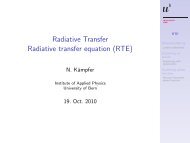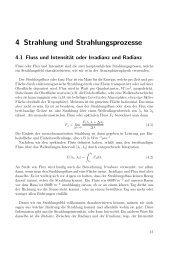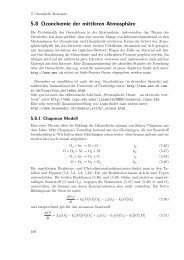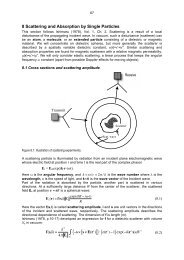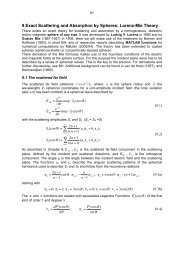Atmospheric Thermodynamics - IAP > Microwave Physics
Atmospheric Thermodynamics - IAP > Microwave Physics
Atmospheric Thermodynamics - IAP > Microwave Physics
You also want an ePaper? Increase the reach of your titles
YUMPU automatically turns print PDFs into web optimized ePapers that Google loves.
N. Kämpfer<br />
<strong>Atmospheric</strong> <strong>Thermodynamics</strong><br />
<strong>Atmospheric</strong><br />
<strong>Thermodynamics</strong><br />
Aim<br />
Gas law<br />
N. Kämpfer<br />
Institute of Applied <strong>Physics</strong><br />
University of Bern<br />
Pressure<br />
Hydrostatic<br />
equilibrium<br />
Scale height<br />
Mixing<br />
Column density<br />
Temperature<br />
Lapse rate<br />
Stability<br />
Condensation<br />
Humidity<br />
Saturation vapor<br />
pressure<br />
Clouds<br />
Outline<br />
Aim<br />
Gas law<br />
Pressure<br />
Hydrostatic equilibrium<br />
Scale height<br />
Mixing<br />
Column density<br />
Temperature<br />
Lapse rate<br />
Stability<br />
Condensation<br />
Humidity<br />
Saturation vapor pressure<br />
Clouds<br />
N. Kämpfer<br />
<strong>Atmospheric</strong><br />
<strong>Thermodynamics</strong><br />
Aim<br />
Gas law<br />
Pressure<br />
Hydrostatic<br />
equilibrium<br />
Scale height<br />
Mixing<br />
Column density<br />
Temperature<br />
Lapse rate<br />
Stability<br />
Condensation<br />
Humidity<br />
Saturation vapor<br />
pressure<br />
Clouds
Aim<br />
A planetary atmosphere consists of different gases hold to<br />
the planet by gravity<br />
The laws of thermodynamics hold<br />
◮ pressure structure<br />
◮ pressure as vertical coordinate<br />
→ some planets have no solid surface<br />
◮ hydrostatic equilibrium<br />
◮ scale height<br />
◮ column density<br />
◮ mean free path<br />
◮ temperature structure<br />
◮ lapse rate<br />
◮ stability<br />
◮ latent heat and condensation → clouds<br />
N. Kämpfer<br />
<strong>Atmospheric</strong><br />
<strong>Thermodynamics</strong><br />
Aim<br />
Gas law<br />
Pressure<br />
Hydrostatic<br />
equilibrium<br />
Scale height<br />
Mixing<br />
Column density<br />
Temperature<br />
Lapse rate<br />
Stability<br />
Condensation<br />
Humidity<br />
Saturation vapor<br />
pressure<br />
Clouds<br />
◮ wet lapse rate<br />
N. Kämpfer<br />
Ideal gas law<br />
pV = NkT<br />
N amount of particles<br />
k = 1.381 · 10 −23 J/K is Boltzmann’s constant<br />
n = N/V is the number density, particles per Volume<br />
a mole contains N A = 6.022 · 10 23 particles<br />
a kmole contains N A = 6.022 · 10 26 particles<br />
with q moles of a substance N = qN A and the gas law gets<br />
pV = qN A kT = nRT<br />
where R = kN A<br />
R = 8.314 J mol −1 K −1 resp.<br />
R = 8314 J kmol −1 K −1 is the universal gas constant<br />
<strong>Atmospheric</strong><br />
<strong>Thermodynamics</strong><br />
Aim<br />
Gas law<br />
Pressure<br />
Hydrostatic<br />
equilibrium<br />
Scale height<br />
Mixing<br />
Column density<br />
Temperature<br />
Lapse rate<br />
Stability<br />
Condensation<br />
Humidity<br />
Saturation vapor<br />
pressure<br />
Clouds<br />
The mass of a mole of substance is called molar weight:<br />
M water = 18.016 kg/kmol M air = 28.97 kg/kmol
Ideal gas law<br />
mass of q moles is m = qM<br />
density ρ can be expressed as<br />
ρ = m V = qM V<br />
very often gas law is expressed as<br />
or<br />
= Mp<br />
RT<br />
pV = m M RT = m R M T = mR G T<br />
p = ρR G T<br />
R G is the gas constant for the gas under discussion!<br />
for dry air R d = 287 JK −1 kg −1<br />
for water vapor R v = 461 JK −1 kg −1<br />
N. Kämpfer<br />
<strong>Atmospheric</strong><br />
<strong>Thermodynamics</strong><br />
Aim<br />
Gas law<br />
Pressure<br />
Hydrostatic<br />
equilibrium<br />
Scale height<br />
Mixing<br />
Column density<br />
Temperature<br />
Lapse rate<br />
Stability<br />
Condensation<br />
Humidity<br />
Saturation vapor<br />
pressure<br />
Clouds<br />
Don’t mix up R G and R !!<br />
In the literature often R is written as R ∗ and R G as R!<br />
Partial pressure<br />
An atmosphere is a mixture of gases<br />
Dalton’s law: The total pressure p is the sum of the partial<br />
pressures of each component p j<br />
p = p 1 + p 2 + p 3 + ... = ∑ p j<br />
The partial pressure of water vapor is denoted by e and is<br />
called vapor pressure<br />
For relative amounts of gases it follows<br />
N j<br />
N = V j<br />
V = p j<br />
p<br />
This is the volume mixing ratio, or VMR often expressed in<br />
ppm or ppb or even ppt → trace gases<br />
The mass mixing ratio is defined as<br />
N. Kämpfer<br />
<strong>Atmospheric</strong><br />
<strong>Thermodynamics</strong><br />
Aim<br />
Gas law<br />
Pressure<br />
Hydrostatic<br />
equilibrium<br />
Scale height<br />
Mixing<br />
Column density<br />
Temperature<br />
Lapse rate<br />
Stability<br />
Condensation<br />
Humidity<br />
Saturation vapor<br />
pressure<br />
Clouds<br />
MMR = ρ i<br />
ρ = m i<br />
m<br />
in gkg−1
Most abundant gases in planetary atmospheres<br />
N. Kämpfer<br />
<strong>Atmospheric</strong><br />
<strong>Thermodynamics</strong><br />
Aim<br />
Gas law<br />
Pressure<br />
Hydrostatic<br />
equilibrium<br />
Scale height<br />
Mixing<br />
Column density<br />
Temperature<br />
Lapse rate<br />
Stability<br />
Condensation<br />
Humidity<br />
Saturation vapor<br />
pressure<br />
Clouds<br />
copied from Y.Yung: Photochemistry of planetary atmospheress<br />
VMR of gases in Earth atmosphere<br />
N. Kämpfer<br />
<strong>Atmospheric</strong><br />
<strong>Thermodynamics</strong><br />
Aim<br />
Gas law<br />
Pressure<br />
Hydrostatic<br />
equilibrium<br />
Scale height<br />
Mixing<br />
Column density<br />
Temperature<br />
Lapse rate<br />
Stability<br />
Condensation<br />
Humidity<br />
Saturation vapor<br />
pressure<br />
Clouds
Mean molecular weight versus height for Earth<br />
N. Kämpfer<br />
<strong>Atmospheric</strong><br />
<strong>Thermodynamics</strong><br />
Aim<br />
Gas law<br />
copied from C.Bohren: <strong>Atmospheric</strong> <strong>Thermodynamics</strong><br />
Pressure<br />
Hydrostatic<br />
equilibrium<br />
Scale height<br />
Mixing<br />
Column density<br />
Temperature<br />
Lapse rate<br />
Stability<br />
Condensation<br />
Humidity<br />
Saturation vapor<br />
pressure<br />
Clouds<br />
Why this shape of the curve?<br />
→ we have to look in more detail at the pressure behavior<br />
Hydrostatic equilibrium<br />
As a gas is compressible → density falls with altitude<br />
Vertical pressure profile can be predicted by considering<br />
change in overhead force, dF , for a change in altitude dz in<br />
a column of gas with density ρ and area A<br />
dF = −ρgAdz<br />
Pressure and altitude are related by hydrostatic equilibrium<br />
dp = −ρgdz<br />
For an ideal gas at temperature T → ρ = Mp<br />
RT<br />
( ∫ z<br />
)<br />
Mg<br />
p(z) = p(z 0 ) exp −<br />
z 0<br />
RT dz<br />
N. Kämpfer<br />
<strong>Atmospheric</strong><br />
<strong>Thermodynamics</strong><br />
Aim<br />
Gas law<br />
Pressure<br />
Hydrostatic<br />
equilibrium<br />
Scale height<br />
Mixing<br />
Column density<br />
Temperature<br />
Lapse rate<br />
Stability<br />
Condensation<br />
Humidity<br />
Saturation vapor<br />
pressure<br />
Clouds<br />
M, g, T depend on the planet and on height
Scale height<br />
Assume T does not vary much and take an average T av<br />
(<br />
p(z) = p 0 exp − Mg )<br />
z<br />
RT av<br />
The quantity RT av<br />
Mg<br />
→ scale height (Skalenhöhe) H<br />
has dimensions of a length<br />
H = RT av<br />
Mg<br />
= R G T av<br />
g<br />
Hydrostatic law expressed with H<br />
(<br />
p = p 0 exp − z )<br />
(<br />
H<br />
n = n 0 exp − z )<br />
(<br />
H<br />
ρ = ρ 0 exp − z )<br />
H<br />
= kT av<br />
mg<br />
N. Kämpfer<br />
<strong>Atmospheric</strong><br />
<strong>Thermodynamics</strong><br />
Aim<br />
Gas law<br />
Pressure<br />
Hydrostatic<br />
equilibrium<br />
Scale height<br />
Mixing<br />
Column density<br />
Temperature<br />
Lapse rate<br />
Stability<br />
Condensation<br />
Humidity<br />
Saturation vapor<br />
pressure<br />
Clouds<br />
Scale height for different planets<br />
N. Kämpfer<br />
<strong>Atmospheric</strong><br />
<strong>Thermodynamics</strong><br />
Aim<br />
Gas law<br />
Pressure<br />
Hydrostatic<br />
equilibrium<br />
Scale height<br />
Mixing<br />
Column density<br />
Temperature<br />
Lapse rate<br />
Stability<br />
Condensation<br />
Humidity<br />
Saturation vapor<br />
pressure<br />
Clouds<br />
from Y.Yung<br />
Physical properties of planetary atmospheres at 1 bar
Discussion of hydrostatic law<br />
How well do these expressions fit with reality?<br />
N. Kämpfer<br />
<strong>Atmospheric</strong><br />
<strong>Thermodynamics</strong><br />
Aim<br />
Gas law<br />
Pressure<br />
Hydrostatic<br />
equilibrium<br />
Scale height<br />
Mixing<br />
Column density<br />
Temperature<br />
Lapse rate<br />
Stability<br />
Condensation<br />
Humidity<br />
Saturation vapor<br />
pressure<br />
Clouds<br />
from Y.Yung<br />
Discussion of scale height<br />
Discussion:<br />
◮ pressure decreases with height faster for lower T<br />
◮ as T ≠ const also H will change<br />
◮ H depends on mass → each constituent would have its<br />
own scale height → own pressure distribution → VMR<br />
of unreactive gases would depend on altitude<br />
but this is not observed!<br />
at least the lower parts of atmospheres behave as they<br />
were built up of a single species with a mean molar mass<br />
Earth: 28.8, Venus and Mars: 44, Jupiter 2.2<br />
N. Kämpfer<br />
<strong>Atmospheric</strong><br />
<strong>Thermodynamics</strong><br />
Aim<br />
Gas law<br />
Pressure<br />
Hydrostatic<br />
equilibrium<br />
Scale height<br />
Mixing<br />
Column density<br />
Temperature<br />
Lapse rate<br />
Stability<br />
Condensation<br />
Humidity<br />
Saturation vapor<br />
pressure<br />
Clouds<br />
Homogeneity of lower atmospheres is a consequence of<br />
mixing due to fluid motions
Homosphere - Turbosphere<br />
N. Kämpfer<br />
<strong>Atmospheric</strong><br />
<strong>Thermodynamics</strong><br />
Aim<br />
Gas law<br />
Pressure<br />
Hydrostatic<br />
equilibrium<br />
Scale height<br />
Mixing<br />
Column density<br />
Temperature<br />
Lapse rate<br />
Stability<br />
Condensation<br />
Humidity<br />
Saturation vapor<br />
pressure<br />
Clouds<br />
Homosphere - Turbosphere<br />
Mixing on a macroscale by<br />
◮ convection<br />
◮ turbulence<br />
◮ small eddies<br />
does not discriminate according molecular mass<br />
Relative importance of molecular and bulk motions depends<br />
on relative distances moved between transport events<br />
For bulk motions → mixing length<br />
For molecular motion → mean free path: λ m<br />
λ m ≈ 1<br />
nσ ≈ 1 kT<br />
σ p<br />
Collision cross section σ of air molecule: ≈ 3 · 10 −15 cm −2<br />
At sea level number density n ≈ 3 · 10 19 cm −3<br />
Average separation between molecules d = n −1/3 ≈ 3.4nm<br />
Mean free path λ m ≈ 0.1µm, i.e. ≈ 30d<br />
N. Kämpfer<br />
<strong>Atmospheric</strong><br />
<strong>Thermodynamics</strong><br />
Aim<br />
Gas law<br />
Pressure<br />
Hydrostatic<br />
equilibrium<br />
Scale height<br />
Mixing<br />
Column density<br />
Temperature<br />
Lapse rate<br />
Stability<br />
Condensation<br />
Humidity<br />
Saturation vapor<br />
pressure<br />
Clouds
Homosphere - Turbosphere<br />
N. Kämpfer<br />
<strong>Atmospheric</strong><br />
<strong>Thermodynamics</strong><br />
Transition region in an atmosphere<br />
from turbulent mixing to diffusion is<br />
known as the turbopause or<br />
homopause<br />
For the Earth both lengths are approx. equal at 100-120 km<br />
Well mixed region below turbopause: homosphere<br />
Gravitationally separated region above: heterospehre<br />
Aim<br />
Gas law<br />
Pressure<br />
Hydrostatic<br />
equilibrium<br />
Scale height<br />
Mixing<br />
Column density<br />
Temperature<br />
Lapse rate<br />
Stability<br />
Condensation<br />
Humidity<br />
Saturation vapor<br />
pressure<br />
Clouds<br />
Column density<br />
The total content in a column of unit cross section of an<br />
atmosphere with a constant scale height is given by the<br />
column density<br />
N c =<br />
∫ ∞<br />
0<br />
ndz = n 0 exp<br />
(<br />
− z )<br />
dz = n 0 H = p 0<br />
H<br />
mg 0<br />
Column density in its general form is also used for particle<br />
distributions that do not obey the exponential law<br />
Total mass of a planetary atmosphere can be expressed by<br />
( ) p<br />
M atm = 4πR0<br />
2 g<br />
s<br />
N. Kämpfer<br />
<strong>Atmospheric</strong><br />
<strong>Thermodynamics</strong><br />
Aim<br />
Gas law<br />
Pressure<br />
Hydrostatic<br />
equilibrium<br />
Scale height<br />
Mixing<br />
Column density<br />
Temperature<br />
Lapse rate<br />
Stability<br />
Condensation<br />
Humidity<br />
Saturation vapor<br />
pressure<br />
Clouds<br />
where s is at the surface (whatever this is ☹)
Temperature profile of Earth<br />
N. Kämpfer<br />
<strong>Atmospheric</strong><br />
<strong>Thermodynamics</strong><br />
Aim<br />
Gas law<br />
Pressure<br />
Hydrostatic<br />
equilibrium<br />
Scale height<br />
Mixing<br />
Column density<br />
Temperature<br />
Lapse rate<br />
Stability<br />
Condensation<br />
Humidity<br />
Saturation vapor<br />
pressure<br />
Clouds<br />
from Jacobson: <strong>Atmospheric</strong> modeling<br />
Thermal structure<br />
The thermal structure of an atmosphere is the result of an<br />
interaction between radiation, composition and dynamics<br />
Equation that governs the thermal structure (without proof)<br />
dT<br />
ρc p<br />
dt + dΦ c<br />
dz<br />
+ dΦ k<br />
dz<br />
= q<br />
C p = heat capacity per unit mass at constant pressure<br />
q = net heating rate = rate of heating - rate of cooling<br />
Φ c = conduction heat flux<br />
Φ k = convection heat flux<br />
Φ c = −K dT<br />
dz<br />
Φ k = −K H ρc p<br />
( dT<br />
dz − g c p<br />
)<br />
K=thermal conductivity and K H =eddy diffusivity<br />
N. Kämpfer<br />
<strong>Atmospheric</strong><br />
<strong>Thermodynamics</strong><br />
Aim<br />
Gas law<br />
Pressure<br />
Hydrostatic<br />
equilibrium<br />
Scale height<br />
Mixing<br />
Column density<br />
Temperature<br />
Lapse rate<br />
Stability<br />
Condensation<br />
Humidity<br />
Saturation vapor<br />
pressure<br />
Clouds
Thermal structure<br />
dT<br />
ρc p<br />
dt + dΦ c<br />
dz<br />
+ dΦ k<br />
dz<br />
= q<br />
N. Kämpfer<br />
<strong>Atmospheric</strong><br />
<strong>Thermodynamics</strong><br />
◮ First term only important for modeling diurnal variations<br />
◮ Third term (convection) dominates in the troposphere<br />
◮ Fourth term dominates in the middle atmosphere<br />
◮ Second term (conduction) balances the fourth term in<br />
the thermosphere<br />
Thermal structure of a planetary atmosphere depends on the<br />
chemical composition<br />
Chemical composition may be affected by<br />
◮ temperature through temperature dependent reactions<br />
Aim<br />
Gas law<br />
Pressure<br />
Hydrostatic<br />
equilibrium<br />
Scale height<br />
Mixing<br />
Column density<br />
Temperature<br />
Lapse rate<br />
Stability<br />
Condensation<br />
Humidity<br />
Saturation vapor<br />
pressure<br />
Clouds<br />
◮ condensation of chemical species<br />
Temperature profile of inner planets<br />
N. Kämpfer<br />
<strong>Atmospheric</strong><br />
<strong>Thermodynamics</strong><br />
Aim<br />
Gas law<br />
Pressure<br />
Hydrostatic<br />
equilibrium<br />
Scale height<br />
Mixing<br />
Column density<br />
Temperature<br />
Lapse rate<br />
Stability<br />
Condensation<br />
Humidity<br />
Saturation vapor<br />
pressure<br />
Clouds
Temperature profile of outer planets<br />
N. Kämpfer<br />
<strong>Atmospheric</strong><br />
<strong>Thermodynamics</strong><br />
Aim<br />
Gas law<br />
Pressure<br />
Hydrostatic<br />
equilibrium<br />
Scale height<br />
Mixing<br />
Column density<br />
Temperature<br />
Lapse rate<br />
Stability<br />
Condensation<br />
Humidity<br />
Saturation vapor<br />
pressure<br />
Clouds<br />
Lapse rate<br />
Radiative transfer tends to produce highest temperatures at<br />
the lowest altitudes<br />
→ hot, lighter air lies under cold, heavier air<br />
→ one would guess that convection would arise, BUT<br />
gases are compressible and pressure decreases with height<br />
→ rising air parcel will expand, will do work on the<br />
environment<br />
→ air is cooled<br />
Consequence:<br />
Temperature drop from expansion can exceed decrease in<br />
temperature of surrounding atmosphere<br />
→ in that case convection will not occur!<br />
N. Kämpfer<br />
<strong>Atmospheric</strong><br />
<strong>Thermodynamics</strong><br />
Aim<br />
Gas law<br />
Pressure<br />
Hydrostatic<br />
equilibrium<br />
Scale height<br />
Mixing<br />
Column density<br />
Temperature<br />
Lapse rate<br />
Stability<br />
Condensation<br />
Humidity<br />
Saturation vapor<br />
pressure<br />
Clouds<br />
What is the decrease in temperature with altitude?<br />
What is the lapse rate?
Lapse rate<br />
Consider air parcel thermally insulated from environment<br />
Air parcel can move up and down under adiabatic conditions<br />
First law of Th.D.<br />
Enthalpy<br />
dU = dq + dW = dU − pdV<br />
dH = dU + pdV + Vdp<br />
For our case → dH = Vdp<br />
Heat capacity at constant pressure C p = (dH/dT ) p<br />
C p dT = Vdp<br />
dp = −ρgdz from hydrostatic equilibrium<br />
C p dT = −V ρgdz<br />
For a unit mass of gas (c p ) we get<br />
− dT<br />
dz = g c p<br />
= Γ d<br />
Γ d is called the dry adiabatic lapse rate<br />
N. Kämpfer<br />
<strong>Atmospheric</strong><br />
<strong>Thermodynamics</strong><br />
Aim<br />
Gas law<br />
Pressure<br />
Hydrostatic<br />
equilibrium<br />
Scale height<br />
Mixing<br />
Column density<br />
Temperature<br />
Lapse rate<br />
Stability<br />
Condensation<br />
Humidity<br />
Saturation vapor<br />
pressure<br />
Clouds<br />
Lapse rate for different planets<br />
N. Kämpfer<br />
<strong>Atmospheric</strong><br />
<strong>Thermodynamics</strong><br />
Aim<br />
Gas law<br />
from Y.Yung<br />
Physical properties of planetary atmospheres at 1 bar<br />
Pressure<br />
Hydrostatic<br />
equilibrium<br />
Scale height<br />
Mixing<br />
Column density<br />
Temperature<br />
Lapse rate<br />
Stability<br />
Condensation<br />
Humidity<br />
Saturation vapor<br />
pressure<br />
Clouds
Stability<br />
Actual temperature gradient of atmosphere: Γ = − dT<br />
dz<br />
◮ Γ < Γ d<br />
→ any attempt of an air packet to rise is counteracted<br />
by cooling → packet gets colder and denser, it sinks<br />
→ any attempt of an air packet to sink is counteracted<br />
by warming → packet gets warmer and lighter, it rises<br />
→ atmosphere is stable<br />
◮ Γ > Γ d<br />
→ any attempt of an air packet to rise is enforced by<br />
warming → packet gets warmer and lighter, it continues<br />
to rise<br />
→ any attempt of an air packet to sink is enforced by<br />
cooling → packet gets colder and denser, it continues<br />
to sink<br />
→ convection is working → atmosphere is unstable<br />
Actual Γ rarely exceed Γ d by more than a very small amount<br />
N. Kämpfer<br />
<strong>Atmospheric</strong><br />
<strong>Thermodynamics</strong><br />
Aim<br />
Gas law<br />
Pressure<br />
Hydrostatic<br />
equilibrium<br />
Scale height<br />
Mixing<br />
Column density<br />
Temperature<br />
Lapse rate<br />
Stability<br />
Condensation<br />
Humidity<br />
Saturation vapor<br />
pressure<br />
Clouds<br />
Stability<br />
N. Kämpfer<br />
<strong>Atmospheric</strong><br />
<strong>Thermodynamics</strong><br />
Aim<br />
Gas law<br />
Pressure<br />
Hydrostatic<br />
equilibrium<br />
Scale height<br />
Mixing<br />
Column density<br />
Temperature<br />
Lapse rate<br />
Stability<br />
Condensation<br />
Humidity<br />
Saturation vapor<br />
pressure<br />
Clouds<br />
DALR=dry adiabatic lapse rate
Condensation<br />
However: Presence of condensable vapors in atmospheric<br />
gases complicates matters!<br />
◮ Condensation to liquid or solid releases latent heat to<br />
the air parcel<br />
◮ For a saturated vapor, every decrease in temperature is<br />
accompanied by additional condensation<br />
◮ Saturated adiabatic lapse rate, Γ s , must be smaller<br />
than Γ d<br />
◮ Clouds can form<br />
◮ Clouds are mainly made of H 2 O for the Earth, but not<br />
alone, e.g. PSC are HNO 3<br />
◮ Clouds on giant planets made from NH3 , H 2 S, CH 4<br />
◮ Clouds on Mars from CO2 and on Venus from H 2 SO 4<br />
N. Kämpfer<br />
<strong>Atmospheric</strong><br />
<strong>Thermodynamics</strong><br />
Aim<br />
Gas law<br />
Pressure<br />
Hydrostatic<br />
equilibrium<br />
Scale height<br />
Mixing<br />
Column density<br />
Temperature<br />
Lapse rate<br />
Stability<br />
Condensation<br />
Humidity<br />
Saturation vapor<br />
pressure<br />
Clouds<br />
For the derivation of Γ s we need Clausius -Clapeyron<br />
equation<br />
Humidity<br />
Different ways to express humidity in the atmosphere:<br />
Mixing ratio g/kg<br />
w ≡ m v<br />
m d<br />
= ρ v<br />
ρ d<br />
= M v<br />
M d<br />
e<br />
p − e<br />
N. Kämpfer<br />
<strong>Atmospheric</strong><br />
<strong>Thermodynamics</strong><br />
where e is the partial pressure of water vapor<br />
As p ≫ e and with M v<br />
M d<br />
= ε = 0.622:<br />
w ≈ 0.622 e p<br />
As long there is no condensation or evaporation the mixing<br />
ratio is conserved!<br />
Specific humidity is defined as<br />
s = ρ v<br />
ρ =<br />
ρ v<br />
ρ d + ρ v<br />
=<br />
eε<br />
p − (1 − ε)e<br />
Aim<br />
Gas law<br />
Pressure<br />
Hydrostatic<br />
equilibrium<br />
Scale height<br />
Mixing<br />
Column density<br />
Temperature<br />
Lapse rate<br />
Stability<br />
Condensation<br />
Humidity<br />
Saturation vapor<br />
pressure<br />
Clouds
Saturation vapor pressure<br />
Equilibrium between condensation and evaporation<br />
→ saturation vapor pressure e s<br />
→ is valid for other gases than water vapor<br />
Relation between saturation pressure and temperature is<br />
given by equation of Clausius and Clapeyron<br />
de s<br />
dT = 1 T<br />
L v<br />
V v − V l<br />
= 1 T<br />
1<br />
ρ v<br />
l v<br />
− 1 ρ l<br />
where: L v = enthalpy of vaporization<br />
V v resp. V l are volumina of vapor and liquid phases<br />
for H 2 O: l v = 2.5 · 10 6 J/kg<br />
e s ≈ Ce<br />
“ ”<br />
− l v<br />
Rv T<br />
= Ce ( − m v lv<br />
kT )<br />
numerator: energy required to break a water molecule free<br />
from its neighbors<br />
denominator: average molecular kinetic energy available<br />
N. Kämpfer<br />
<strong>Atmospheric</strong><br />
<strong>Thermodynamics</strong><br />
Aim<br />
Gas law<br />
Pressure<br />
Hydrostatic<br />
equilibrium<br />
Scale height<br />
Mixing<br />
Column density<br />
Temperature<br />
Lapse rate<br />
Stability<br />
Condensation<br />
Humidity<br />
Saturation vapor<br />
pressure<br />
Clouds<br />
Saturation vapor pressure<br />
Useful approximation for water vapor:<br />
e s<br />
ln<br />
6.11mb = LM (<br />
v 1<br />
R 273 − 1 )<br />
T<br />
Saturation mixing ratio<br />
w s ≈ 0.622 e s<br />
p<br />
= 19.83 − 5417<br />
T<br />
Relative humidity, RH RH = 100 w w s<br />
= 100 e e s<br />
Dew point is the temperature where RH = 100%<br />
Lapse rate for saturated conditions, Γ s , can be shown to be<br />
Γ s = − dT<br />
dz = g c p<br />
1 + l v w s /RT<br />
1 + l 2 v w s /c p R v T 2<br />
N. Kämpfer<br />
<strong>Atmospheric</strong><br />
<strong>Thermodynamics</strong><br />
Aim<br />
Gas law<br />
Pressure<br />
Hydrostatic<br />
equilibrium<br />
Scale height<br />
Mixing<br />
Column density<br />
Temperature<br />
Lapse rate<br />
Stability<br />
Condensation<br />
Humidity<br />
Saturation vapor<br />
pressure<br />
Clouds<br />
In case of Earth: Γ s ≈ 5K/km in contrast to Γ d ≈ 10K/km
Saturation vapor pressure for water vapor<br />
N. Kämpfer<br />
<strong>Atmospheric</strong><br />
<strong>Thermodynamics</strong><br />
Aim<br />
Gas law<br />
Pressure<br />
Hydrostatic<br />
equilibrium<br />
Scale height<br />
Mixing<br />
Column density<br />
Temperature<br />
Lapse rate<br />
Stability<br />
Condensation<br />
Humidity<br />
Saturation vapor<br />
pressure<br />
Clouds<br />
Clouds, a few facts<br />
◮ Clouds can form on all planets with condensable gases<br />
◮ Temperature must drop below the condensation or<br />
freezing temperature of such gases<br />
◮ Cloud condensation nuclei must be present<br />
◮ Most terrestrial clouds consist of water droplets and ice<br />
crystals but other cloud particles are possible, eg.<br />
HNO 3·2H 2 O or H 2 SO 4 /H 2 O in PSCs<br />
◮ On ♀ exist H 2 SO 4 clouds<br />
◮ On ♂ exist water ice clouds<br />
◮ On titan clouds of CH 4 are expected<br />
◮ NH 3 - ice may form on ♃ and ♄<br />
◮ H 2 S-ice may form on ♅ and and also CH 4 -ice<br />
N. Kämpfer<br />
<strong>Atmospheric</strong><br />
<strong>Thermodynamics</strong><br />
Aim<br />
Gas law<br />
Pressure<br />
Hydrostatic<br />
equilibrium<br />
Scale height<br />
Mixing<br />
Column density<br />
Temperature<br />
Lapse rate<br />
Stability<br />
Condensation<br />
Humidity<br />
Saturation vapor<br />
pressure<br />
Clouds<br />
◮ Clouds are often related to precipitation<br />
◮ Clouds are extremely important for radiation budget<br />
→ often little is known
Polar stratospheric clouds<br />
N. Kämpfer<br />
<strong>Atmospheric</strong><br />
<strong>Thermodynamics</strong><br />
Aim<br />
Gas law<br />
Pressure<br />
Hydrostatic<br />
equilibrium<br />
Scale height<br />
Mixing<br />
Column density<br />
Temperature<br />
Lapse rate<br />
Stability<br />
Condensation<br />
Humidity<br />
Saturation vapor<br />
pressure<br />
Clouds<br />
photo from H.Berg, Karlsruhe<br />
Polar stratospheric clouds<br />
N. Kämpfer<br />
<strong>Atmospheric</strong><br />
<strong>Thermodynamics</strong><br />
Aim<br />
Gas law<br />
Pressure<br />
Hydrostatic<br />
equilibrium<br />
Scale height<br />
Mixing<br />
Column density<br />
Temperature<br />
Lapse rate<br />
Stability<br />
Condensation<br />
Humidity<br />
Saturation vapor<br />
pressure<br />
Clouds
Clouds on Mars<br />
N. Kämpfer<br />
<strong>Atmospheric</strong><br />
<strong>Thermodynamics</strong><br />
Aim<br />
Gas law<br />
Pressure<br />
Hydrostatic<br />
equilibrium<br />
Scale height<br />
Mixing<br />
Column density<br />
Temperature<br />
Lapse rate<br />
Stability<br />
Condensation<br />
Humidity<br />
Saturation vapor<br />
pressure<br />
Clouds<br />
photo from NASA<br />
Clouds on Venus<br />
N. Kämpfer<br />
<strong>Atmospheric</strong><br />
<strong>Thermodynamics</strong><br />
Aim<br />
Gas law<br />
Pressure<br />
Hydrostatic<br />
equilibrium<br />
Scale height<br />
Mixing<br />
Column density<br />
Temperature<br />
Lapse rate<br />
Stability<br />
Condensation<br />
Humidity<br />
Saturation vapor<br />
pressure<br />
Clouds<br />
photo from NASA
Level of cloud formation<br />
The lifting condensation level, LCL, is the level to which a<br />
parcel of air would have to be lifted dry adiabatically to<br />
reach a RH of 100% → base of clouds<br />
Height of LCL is a function of T and humidity resp.<br />
condensable matter<br />
If a parcel with T 0 is lifted from z 0 to height z then<br />
For the dew point at any z<br />
T (z) = T 0 − Γ d (z − z 0 )<br />
T d (z) = T d0 − Γ dew (z − z 0 )<br />
z LCL is reached when both are equal<br />
z LCL = z 0 + T 0 − T do<br />
where Γ dew = − dT d<br />
Γ d − Γ dew dz<br />
= g Td<br />
2<br />
ɛl v T<br />
N. Kämpfer<br />
<strong>Atmospheric</strong><br />
<strong>Thermodynamics</strong><br />
Aim<br />
Gas law<br />
Pressure<br />
Hydrostatic<br />
equilibrium<br />
Scale height<br />
Mixing<br />
Column density<br />
Temperature<br />
Lapse rate<br />
Stability<br />
Condensation<br />
Humidity<br />
Saturation vapor<br />
pressure<br />
Clouds<br />
→ Rule of thumb: z LCL − z 0 = (T 0 − T d0 )/8 in km-units<br />
Ceilometer at <strong>IAP</strong> for cloud base measurements<br />
N. Kämpfer<br />
<strong>Atmospheric</strong><br />
<strong>Thermodynamics</strong><br />
Aim<br />
Gas law<br />
Pressure<br />
Hydrostatic<br />
equilibrium<br />
Scale height<br />
Mixing<br />
Column density<br />
Temperature<br />
Lapse rate<br />
Stability<br />
Condensation<br />
Humidity<br />
Saturation vapor<br />
pressure<br />
Clouds<br />
Laser-ceilometer<br />
from M.Schneebeli<br />
Cloud base as determined with a ceilometer



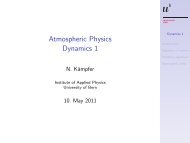
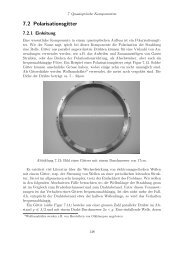
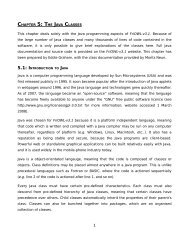
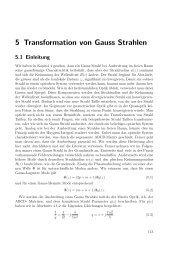
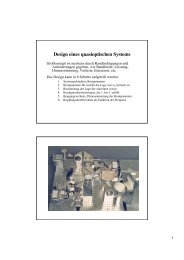
![Kapitel 3: Antennen [4.8 MB]](https://img.yumpu.com/22421230/1/184x260/kapitel-3-antennen-48-mb.jpg?quality=85)
![Kapitel 4: Wellenleiter [4.4 MB]](https://img.yumpu.com/22421225/1/184x260/kapitel-4-wellenleiter-44-mb.jpg?quality=85)


